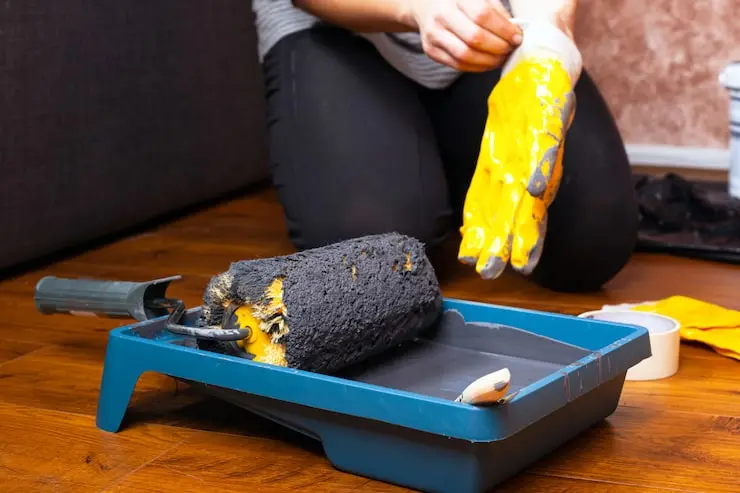Clogged gutters can lead to costly home damage, yet learning how to clean gutters is an accessible, high-impact maintenance task you can undertake right now. The ideal method involves clearing away large debris by hand or scoop, flushing the entire system with garden hose water, and checking downspouts for stubborn blockages. An afternoon’s work should ensure maximum foundational and roofline protection!
This comprehensive guide offers all of the professional tools, safety steps, and repair knowledge necessary for effective gutter cleaning that prevents water damage to your home.
Table of Contents
Tools and Materials You'll Need
Before you start cleaning gutters, gather these essential items. Having everything ready saves trips up and down the ladder.
Basic Tools:
- Extension ladder (for two-story homes) or step ladder
- Ladder stabilizer or standoff bracket
- Heavy-duty work gloves (nitrile gloves for wet debris)
- Safety glasses or goggles
- 5-gallon bucket with S-hook
- Plastic gutter scoop or garden trowel
- Garden hose with spray nozzle
Optional Power Tools:
- Leaf blower with gutter attachment ($40-$80)
- Pressure washer with telescoping wand ($150-$300)
- Wet/dry vacuum with extension kit ($60-$120)
Repair Materials:
- Gutter sealant ($8-$15 per tube)
- Roll flashing for rust spots ($20-$30)
- Downspout straps and screws ($5-$10)
The total DIY cost runs $50-$150 if you have basic tools. Compare that to professional gutter cleaning near San Diego, which costs $150-$300 for an average home.
Why Is Gutter Maintenance Important?
Your gutters do one job: move water away from your home. When leaves, twigs, and debris clog them, water backs up and causes serious problems.
- Roof Damage: Water trapped in clogged gutters seeps under shingles. This damages the underlayment and decking. In San Diego, while we don’t deal with ice dams like cold climates, heavy winter rains can still force water under roofing materials. One leak can cost $500-$2,000 to repair.
- Foundation Issues: Overflowing gutters dump water next to your foundation. The soil softens, creating cracks in concrete. Foundation repairs start at $3,000 and can exceed $10,000 for major damage. During Santa Ana wind season, dried leaves pile up fast, making fall cleaning critical for San Diego homes.
- Fascia Board Rot: The weight of debris and standing water pulls gutters away from fascia boards. Water gets behind the boards, causing wood rot. Replacing damaged fascia costs $300-$1,000 per section.
- Mold and Pest Problems: Damp debris in gutters creates perfect breeding grounds for mosquitoes and mold. This affects your home’s air quality and creates health risks.
- The Solution: Clean your gutters twice yearly. Schedule one cleaning in late spring (May) and another in fall (November). San Diego’s mild climate means less debris than areas with harsh winters, but our eucalyptus, oak, and pine trees still drop plenty of leaves.
Regular roof and gutter maintenance prevents these expensive repairs. A $200 annual investment in gutter cleaning saves thousands in damage costs.
Using a Ladder and Gutter Cleaning Safety
More people get injured falling from ladders than any other home maintenance task. Take these precautions seriously.
Ladder Setup:
- Place your ladder on firm, level ground. Never set it on mud or loose soil.
- Use a ladder stabilizer. This keeps the ladder off gutters and prevents damage.
- For two-story homes, use an extension ladder rated for your weight plus 50 pounds.
- Follow the 4-to-1 rule: For every 4 feet of height, move the base 1 foot from the wall.
- Never stand on the top three rungs.
Personal Safety:
- Wear thick work gloves. Gutter edges are sharp and can slice unprotected hands.
- Put on safety glasses. Debris falls in your face when you clean from below.
- Avoid loose clothing that can snag on ladder rungs.
- Wait for dry conditions. Wet roofs are slippery. Clean during midday when morning dew has dried.
Power Line Safety: San Diego homes often have power lines near gutters. If lines run within 10 feet of your gutters, call a professional. Contact with power lines causes serious injury or death.
Work Smart:
- Attach your bucket to the ladder with an S-hook. This keeps both hands free.
- Move the ladder frequently. Don’t stretch or reach beyond your belt buckle.
- Have someone hold the ladder base while you work.
- Take breaks every 30 minutes to avoid fatigue.
If you’re uncomfortable on ladders or have a multi-story home, hire a professional. Your safety is worth more than saving $200.
How To Clean Gutters in 7 Simple Steps

This method works for most homes and requires minimal equipment. Budget 2-3 hours for a typical single-story house.
Step 1: Start with the Downspout
Clear downspouts first so water can drain while you work. Insert your garden hose into the top of the downspout. Turn on full pressure and let water flush out debris. If water backs up, you have a clog.
For stubborn clogs, detach the downspout from the elbow joint. Use a plumber’s snake or dryer vent brush to break up the blockage. The clog usually sits at the elbow where the downspout curves.
Step 2: Remove Large Debris
Put on your gloves and scoop out leaves, twigs, and muck. Start at a downspout outlet and work away from it. This prevents pushing debris into the downspout you just cleared.
Use your plastic scoop or trowel for packed debris. For wet, matted leaves, your gloved hands work better than tools. Drop debris into your bucket or onto a tarp below.
Look for these items while cleaning:
- Shingle granules (indicates roof wear)
- Nests or animal debris
- Broken gutter sections
- Loose fasteners
Step 3: Scrub Stubborn Gunk
Some debris sticks to gutter bottoms. Use a stiff brush or old broom to scrub it loose. For really stuck material, spray it with water first to soften it.
Check gutter corners and end caps. Debris packs tightly in these spots and blocks water flow.
Step 4: Flush the Gutters
After removing debris, spray gutters with your hose. Start at the end farthest from the downspout. Watch how water flows. It should move steadily toward the downspout without pooling.
Keep water pressure moderate. High pressure can loosen gutter fasteners or damage shingles.
Step 5: Test Downspout Flow
Reattach any downspout sections you removed. Spray water into the gutter and watch it drain. Water should exit the downspout quickly with strong flow.
Slow drainage means a remaining clog. Repeat the downspout cleaning process.
Step 6: Inspect and Repair
With clean gutters, check for damage:
- Look for cracks, holes, or rust spots
- Test for loose gutter sections
- Check that gutters slope toward downspouts
- Examine fascia boards for rot or damage
Apply gutter sealant to small cracks or holes. Follow the product instructions for best results. Mark larger problems for professional repair.
Step 7: Consider Gutter Guards
Gutter guards reduce cleaning frequency from twice yearly to once every 2-3 years. They cost $3-$30 per linear foot installed.
Common types:
- Mesh screens ($1-$3 per foot) – DIY friendly, blocks most debris
- Reverse curve ($4-$8 per foot) – Professional install, very effective
- Foam inserts ($2-$3 per foot) – Easy DIY, needs replacement every few years
- Micro-mesh ($5-$10 per foot) – Best performance, highest cost
For San Diego homes with eucalyptus or pine trees, micro-mesh guards work best. They block small needles and seed pods that slip through cheaper screens.
How to Clean Gutters With a Leaf Blower

A leaf blower with a gutter attachment lets you clean from the ground. This method works great for dry debris but struggles with wet, matted leaves.
Equipment Needed:
- Gas or electric leaf blower (minimum 200 CFM)
- Gutter cleaning attachment ($30-$60)
- Safety goggles
- Dust mask
The Process:
Insert the curved attachment into your gutter. Walk along the house, blowing debris out as you go. The attachment’s curve directs air flow into the gutter channel.
Start at the end farthest from the downspout. This prevents blowing debris into the downspout. Work in 3-foot sections, moving slowly for thorough cleaning.
Pros:
- Fast method (30-45 minutes per home)
- No ladder climbing for single-story homes
- Minimal physical effort
Cons:
- Creates a mess around your house
- Doesn’t work well for wet debris
- Can’t inspect gutters closely
- Not suitable near power lines
After blowing, rake up the debris that lands in your yard. You’ll still need to flush gutters with a hose and check downspouts separately.
How To Clean Gutters With Power Washer
A pressure washer tackles wet, stuck-on debris that leaf blowers can’t handle. Use a telescoping wand with a U-shaped or curved gutter cleaning attachment.
Equipment:
- Pressure washer (1500-2000 PSI for gutters)
- Telescoping wand (extends 10-15 feet)
- Gutter cleaning attachment
- Safety goggles and waterproof clothing
Step-by-Step:
- Attach the gutter cleaning wand to your pressure washer
- Start at a downspout location
- Insert the U-shaped nozzle into the gutter
- Trigger the sprayer and move slowly along the gutter
- Work away from the downspout initially, then back toward it
- Flush downspouts separately with direct spray
The high-pressure water blasts away stuck debris and algae growth. It’s particularly useful after storms when leaves are wet and compacted.
Important Notes:
- Use 1500-2000 PSI max. Higher pressure damages gutters and shingles
- Angle spray away from fascia boards to prevent water intrusion
- Expect debris to spray onto siding, windows, and landscaping
- Plan to clean these areas afterward
This method costs more upfront ($150-$300 for equipment) but works faster than hand cleaning. One gutter cleaning hose attachment makes the job easier and keeps you off the ladder.
How To Clean Gutters With Wet/Dry Vacuum
A wet/dry vac removes debris without creating a ground mess. This method works year-round, regardless of debris moisture level.
What You Need:
- 6+ gallon wet/dry vacuum
- Gutter cleaning kit with curved attachment ($30-$50)
- Extension tubes (for ground-level cleaning)
The Method:
Attach the curved tube to your vacuum. The curve reaches into gutters from above. Insert the nozzle into the gutter and move along slowly. The vacuum sucks up leaves, twigs, and muck directly into the canister.
For single-story homes, some kits let you work from the ground with extended poles. Two-story homes require ladder work.
Benefits:
- No ground mess to clean up
- Works with any debris type
- Quieter than leaf blowers
- Can see results immediately
Limitations:
- Slower than other power methods (45-60 minutes)
- Requires frequent canister emptying
- Can’t reach all gutter areas easily
- Still need to flush with water afterward
After vacuuming, flush gutters with a hose to wash remaining dirt down the downspouts.
When to Repair and Replace Gutters
Cleaning reveals damage that needs attention. Here’s how to know when gutters need repair versus replacement.
- Clogged Gutters That Won’t Drain: If gutters overflow after thorough cleaning, the problem is structural. The gutter slope may be incorrect (needs 1/4 inch drop per 10 feet), or your gutters are too small for your roof area. A professional can assess and fix slope issues for $200-$400.
- Sagging Gutter Sections: Gutters pull away from fascia boards when hangers fail or debris weight stresses the system. Tighten loose hangers first. If fascia boards are rotted, those need replacement before reattaching gutters. Cost: $300-$800 per section.
- Loose Downspouts: Tighten the mounting straps and screws. If screw holes are stripped, drill new holes 1-2 inches from the old ones and install new straps. This DIY fix costs under $20.
- Rust and Corrosion: Small rust spots can be patched with self-adhesive roll flashing. Clean the area, dry it completely, and apply the flashing. For widespread rust or brittle metal, replace those gutter sections. Rust repair: $50-$100 DIY. Section replacement: $8-$12 per linear foot.
- Cracks and Holes: Apply gutter sealant to cracks under 2 inches. For holes, use a gutter patch kit. Clean and dry the area first for proper adhesion. Patches work for 2-5 years but aren’t permanent solutions.
- Separated Gutter Joints: Where gutter sections connect, joints can separate. Clean both surfaces, apply gutter sealant, and press together firmly. Use pop rivets or sheet metal screws for extra strength.
Complete Gutter Replacement: Replace gutters when:
- More than 30% shows damage
- The system is over 20 years old
- You’re selling your home soon
- Multiple sections have failed
Replacement costs $4-$9 per linear foot for aluminum gutters, $8-$15 for copper. Average home: $1,200-$2,500 installed.
San Diego’s mild climate means gutters last longer than in freeze-thaw climates. Proper maintenance can extend your gutter life to 25+ years.
Cost Breakdown: DIY vs Professional Gutter Cleaning
DIY Costs:
- One-time equipment: $50-$150
- Supplies per cleaning: $10-$30
- Time investment: 2-4 hours
- Annual cost: $60-$100
Professional Gutter Cleaning Cost:
- Single-story home: $100-$200
- Two-story home: $150-$300
- Three-story home: $250-$400
- Gutter guard installation: $800-$2,500
Factors affecting professional pricing:
- Linear feet of gutters
- Home height and roof pitch
- Tree coverage and debris level
- Access difficulty
- Additional repairs needed
For most San Diego homeowners, DIY makes sense if you’re comfortable on ladders and have a single-story home. Multi-story homes or properties with extensive tree coverage benefit from professional service.
Get Help With Gutter Cleaning
Not everyone should climb ladders to clean gutters. Consider professional help if you:
- Have a two-story or three-story home
- Live in an area with heavy tree coverage
- Have mobility or balance issues
- Feel uncomfortable on ladders
- Don’t have time for regular maintenance
How do I clean gutters on a three-story home, or how do I handle a deeply rooted downspout clog? Sometimes, the safest and most efficient choice is to hire a professional. They have the training, specialized tools (like industrial gutter cleaners), and insurance to handle high-risk jobs.
For professional assistance with high-access, complex cleaning, or any home repairs and inspections, you can contact San Diego Home Remodeling. We offer comprehensive handyman san diego services that include thorough gutter system cleaning and necessary repairs to protect your home.
Our gutter services include:
- Complete cleaning and debris removal
- Downspout clearing and testing
- Gutter inspection and damage assessment
- Minor repairs (seal leaks, tighten fasteners)
- Gutter guard installation recommendations
Professional service pays for itself when you factor in safety risks and your time value. A $200 professional cleaning takes one hour versus your 3-4 hours plus equipment costs.
Final Thoughts
Clean gutters protect your biggest investment: your home. Whether you DIY or hire professionals, consistent maintenance prevents expensive damage to your roof, foundation, and fascia boards.
San Diego’s mild climate makes gutter maintenance easier than in harsh weather regions, but our trees still create plenty of work. Set calendar reminders for May and November cleaning. Your future self will thank you when you avoid $5,000 foundation repairs.
Start with the method that matches your comfort level and equipment. Hand cleaning works for everyone. Power tools speed things up. Professional service removes all hassle and risk.
The important thing? Get it done. Clean gutters twice a year, every year. That simple habit saves thousands in repair costs and protects your home’s value.
FAQs
What is the best thing to clean gutters with?
For heavy, sticky blockages, a power washer with a telescoping wand is the most effective tool. For dry, loose leaves, a leaf blower extension kit is the fastest option. For safety, tools that allow you to work from the ground are always best.
What are the best gutter cleaning tools for homeowners?
The most valuable tools are a sturdy ladder with a stabilizer, a plastic gutter scoop for manual clearing, and a basic gutter cleaning hose attachment for flushing the system. For clearing downspouts, a plumber’s snake is unbeatable.
Is it safe to clean gutters by yourself?
It can be safe if you follow strict ladder protocols and only work on a one-story home. For multi-story homes, it is risky to perform the work on a ladder without a spotter or professional help. When in doubt, hire a pro.
What is shingle grit and why does it matter?
Shingle grit is the tiny gravel-like material that flakes off your asphalt roof shingles over time. It is heavy and dense, and when mixed with water and leaves, it forms a cement-like sludge that creates the most stubborn clogs in your gutters and downspouts. You must flush this material out with water pressure.








